Believe it or not but Google does change its algorithm at-least once a day if not more. On a yearly basis, they do this at least 500 times. However, these changes are not as high impacting except for the major releases like “Panda”, “Penguin” etc…
Those are the updates that search marketers and businesses need to care about.
A significant trend that potentially will determine the future of SEO is the use of Voice queries especially on mobile.
The expanded usage of smartphone queries and the voice assistants, chattiest etc. have lead to their prominence.
Come to think of it, Voice queries are actually a conversation, a discussion with the sole aim of helping the user complete a task in real-time, such as finding a restaurant, checking the weather, booking a ticket and even making a purchase.
The answers produced need to be highly relevant to the users demand at that instant. Today’s voice results need direct answers in response to the search.
In fact, voice search queries are very different from typical keyword searches that occur in the search box.
Let’s get a little more info on that..
Initially, consumers were not very adaptive of voice search, it didn’t function properly and had its kinks in terms of context and content..
In fact, a large percentage of iOS users said that they didn’t use Siri at all, that number was over 90%.
Fast forward to today, Siri and Google now are the leading voice search assistants on the planet.
In this post, I’ll show you how voice search can actually improve your branding when targeting customers in a given locality via search engines – think hyperlocal..
You’ll also learn first hand how to simplify local SEO by optimizing for voice searches in a way that will appeal to your target audience.
The impact of voice search is evident all around us, from Siri and Cortana to Google Home and Alexa. Although voice search hasn’t reached mainstream adoption yet, this is the right time for brands to get in and get the benefits.
According to National Public Media, 1 in 6 Americans owns a voice-activated smart-speaker. And 32% of US adults own a Smart Speaker. So the use of voice technology will increase.
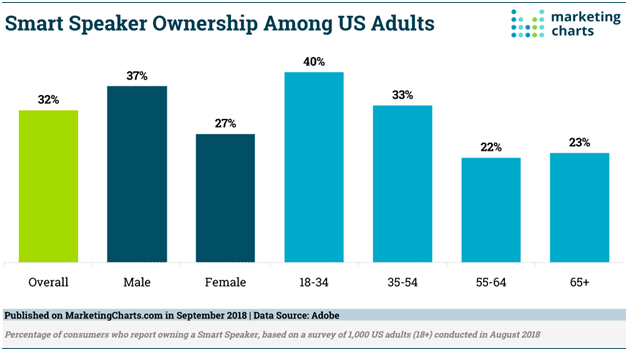
About four years ago when Gartner predicted the future impact of smart machines, it was noted that 30% of human interactions with technology would happen seamlessly with these AI-empowered voice machines.
And we see this happening already, with a promise to get bigger in the nearest future.
Essentially, voice search has redefined the abstract elements and conveyed them to the physical environment via these smart machines.
In the past, businesses know that certain aspects of branding such as tone, voice, personality, were intangible — but they will soon become real in ways the target audience will better appreciate them.
In the same way that mass marketing has shifted into digital marketing, we’re now experiencing the dawn of conversational marketing with voice search.
Trust me, it’s time your brand makes a move into the world of voice searches.
It doesn’t matter how long you’ve been in business and whether you’re comfortable with traditional searches, adapting to voice-assisted technology can transform your brand.
So, how can you boost your online presence towards this shift in consumer behavior
How Brands Are Making a Shift To Voice Search
In the retail market, a lot is already happening and shifting the norm. For instance, in the US, Domino’s has implemented it’s one-click Easy Orders option through Alexa, and the brand is already recording tremendous results.
Two months into the campaign, 20% of consumers who signed up with Easy Orders have used Alexa for the service, according to Nick Dutch, Head of Digital for Domino’s UK.

By targeting the offering to the existing easy orders option, we see how voice dominates and impacts. This is possible because voice commerce is all about convenience, that’s what consumers want.
There needs to be a balance between engineering innovation and maintenance. Or better yet, improving customer satisfaction, as indicated by the number of one-star reviews from all three brands in the Alexa Skills Store to date.
Google, in particular, is concerned about search driven eCommerce. And their entire business model runs on user satisfaction which depends on search results.
Therefore, Google would do everything to fan the flame of voice search since search users love it.
Google’s actions so far have shown the company’s alternative solution to Alexa Skills — although not heavily publicized as Skills so far, and how it applies to consumers is not as explicit, but it’s sure going to make a tremendous impact on voice search.
Amazon’s edge and strength lie in Retail, while Google thrives in Search. However, we’re expecting a new development from both brands in areas that will drive voice search.
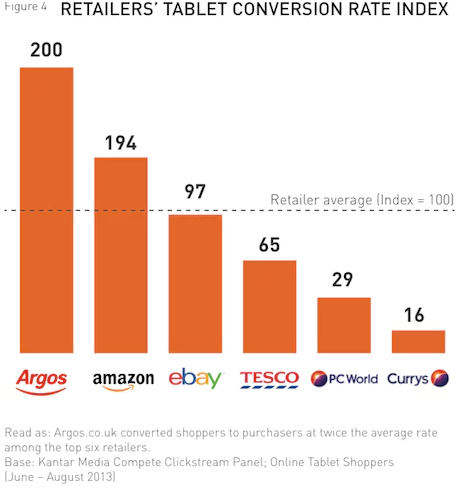
Source: MarketingWeek
We expect Amazon to continually improve the way it surfaces information, although the end goal may be to still move the user closer making a purchase with every query.
Alexa’s technology is designed to query several resources for information, including Bing, Yelp, and other databases of enabled Skills such as WebMD for medical queries.
Without a dominance in this space, we envision that Amazon will continuously rely on third partners to sustain the value of its responses, unveiling new opportunities for technology and data platforms, as well as brands.
How Brands Can Capitalize on Voice Search Technology
Whether you like it or not, we’re entering an era where the voice will dominate search. This is already happening. As of January 2018, there were an estimated 1 billion voice searches per month.
But that’s not all, comScore estimates that by 2020, more than 50% of all searches will be conducted via voice search. You may have noticed your friends and coworkers shifting towards voice search, and if you haven’t, you should expect to see them in the next few years.
In fact, Voice Commerce Sales will skyrocket to $5 billion in the UK and $40 billion in the United States by 2022.
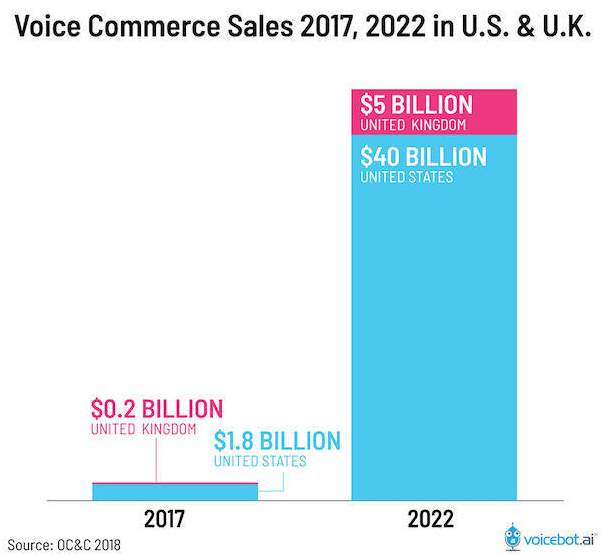
In your personal life, it’s time to decide whether you want to stick to traditional methods or utilize a more conversational mode of search.
For marketers, though, the real challenge is how to take advantage of this rise is voice search volume to drive online campaigns.
1) Research the Trend
When it comes to voice search, data is important.
That’s why researching the trend is fundamental to your success. You can start by analyzing how customers interact with your brand.
Check your web analytics (Google Analytics, will do) and you might see the search queries that are conversational in nature and longer than your typical 1 to 3 keyword.

These queries may not show a ‘commercial intent,’ but they’re useful when you’re ready to launch a full-blown voice search campaign for your website.
And by that, I’m talking about optimizing your new pages for voice-related searches or updating existing pages with the same.
Either way, it works.
When you look at your other web analytics, you can easily tell how customers use the Live Chat function on your app or website. How did they navigate your pages, which search terms brought them to your website?
Take notes of these insights and analyze conversations in focus groups.
One of the benefits of looking at the search queries that brought customers to your store is to be able to determine the variations of those queries that are conversational in nature.
For example, if users came to your product page through this search query “Running Shoes for Women,” then you could look for its related term that is used in voice searches such as:
- What is the best running shoes for a woman?
- Do women wear running shoes for the workout?
- What running shoes does Katy Perry wear?
And so on…
Voice searches usually begins with Who, How, When, Where, What, etc. Online users who search with these modifiers are interested in your offer and are ready to act, according to Moz.

2) Experimentation
This is a critical part of the voice search that would impact your brand’s visibility in the organic search. In experimentation, start by interacting with any available voice assistant available to you, in your Smartphone.

You may even buy a smart speaker and you’ll see firsthand how it applies to different areas of your life, more so, when you’re conducting a Google search.
What’s the need for experimentation?
Well, experimentation puts you right in the users’ shoes. You get to understand exactly what they’re up to when they use voice searches to find information on Google.
This should give you a better idea as to what keywords to choose, why you’re choosing them, and how to create compelling content to address these voice searches.
3) User Experience
It gets even exciting when you incorporate voice as an integral aspect of your customer’s experience. In other words, you aren’t hitting your goal if voice searchers can’t find your pages on the web.
You want them to see and feel your brand as well as your products and services when they speak into their microphone to find information.

To get this going, with all the information you pulled about your customer while researching the trend via web analytics, you want to:
Map out your customer profile and capitalize on voice and tone to drive your brand identity. The goal is to add more value or minimize friction.
- Examine the customer’s journey: Find out the search queries they’re using early and late in the buying process, and what the type of content that answers their queries better.
- Determine that context of these search queries: Do you think the queries will sound good through voice, and how well could audio content answer their question succinctly? Voice search is conversational, so think in that light: more like a screenplay and less like fragmented statements.
- Optimize your on-site content for voice search: I mentioned earlier that you have two options: You either optimize a new page for voice search or update an existing page with voice-related queries. This is a good way to get more visibility regardless of what approach, typing or speaking, your customers are searching.
4) Create a Skill
It may be the right time for your brand to review the potentials of Alexa Skills (which has achieved remarkable milestones) that some retailers such as Domino’s, and early adopters like Ticketmaster.

Do you think your brand can deliver a one-touch ordering solution? If you take a leaf from Domino’s Easy Order, what can you improve to make your brand stand out?
Better yet, what can you do to facilitate and simplify other parts of the customer journey, before and after a purchase?
Do you have the tools and system in place to keep customers coming back?
Trial an appropriate Skill or Action; it doesn’t make sense to promise more than you can confidently deliver, it’s always better to drive ease and convenience in your service, and let it speak for you.
5) Create Content That Sounds Google On Audio
Your brand gives you an opportunity to respond to conversational queries that customers are using in a voice search. Nothing beats a well-optimized page that pops up each time users speak their questions.
Today, a lot of people are turning to smart machines to ask questions. I’m thinking we’re living in a “Question and Answer Era.” The only edge you have is being able to respond in kind to these question.

Source: Inc.
At the end of the day, it boils down to creating compelling content that will appeal to these voice users in the search.
Create content that sounds smooth and good to the ear when readout aloud — usually in the form of answering a given question. Ideally, answer the question first in your content before giving additional information.
It’s always good to refer to the Inverted Pyramid that Journalists use when creating content for the web or print.
For example, if a user asks via voice “where does Serena Williams live?”, then your first line/sentence must provide that answer.
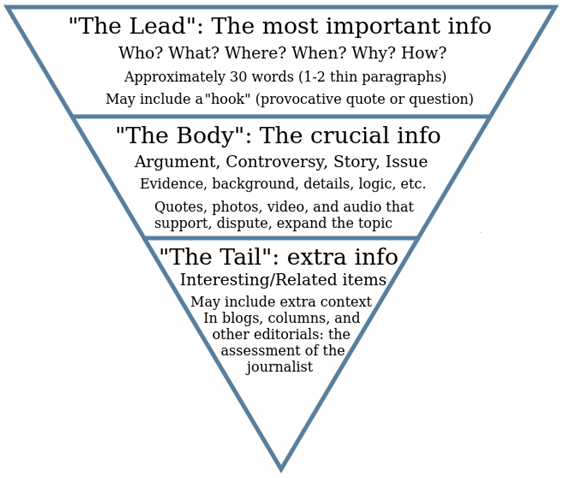
Next, you can talk about her career, where she lived previously, her net worth, and why she chose to live in this new environment. Do you get the idea?
6) Does Your Brand Sound Good?
Another important aspect of branding with respect to voice searches is being able to know how your brand sounds in audio. Here’s why it’s important?
Google sounds like Google and Alexa sounds like Alexa. Great brands don’t sound different regardless of the mode of search used.
Truly, voice search may become highly customized in the future, thus, giving brands the ability to choose their own vocal characteristics, but in the meantime, make sure your brand is good when read out loud.
Let’s assume your brand was a real person, what would they sound like? How do you determine:
- Age
- Gender
- Temperament
- Personality
- Language
- Conversational Tone
- Conversational speed
These are thoughtful questions to consider. Your customers want your brand to sound as if it were a human. Trust me, if your brand can listen to them and understand their questions better, then they can be sure of a worthwhile answer.
By language, I’m not referring to American, English, or French, I’m talking about a language your target audience understands.
For example, in the medical field, there’s a language they understand. That’s what you should speak in your content.
In the Finance and Investment markets, they have their own language which could be strange to academics.
7) Early Adopters Win
In the online marketing world, the first-mover advantage applies. For example, brands that first ventured into influencer marketing cashed out.
The same rule applies to voice search.
Given that voice search is still fairly new and hasn’t yet reached mass adoption, your brand can grab this opportunity to dominate the market before other brands catch up.
You can reap first-mover advantages even if you’re not a strong brand yet, all you have to do is start now.
That’s exactly what Yahoo!, Google, and Amazon did when they came on the scene, and now, there’s no stopping them.
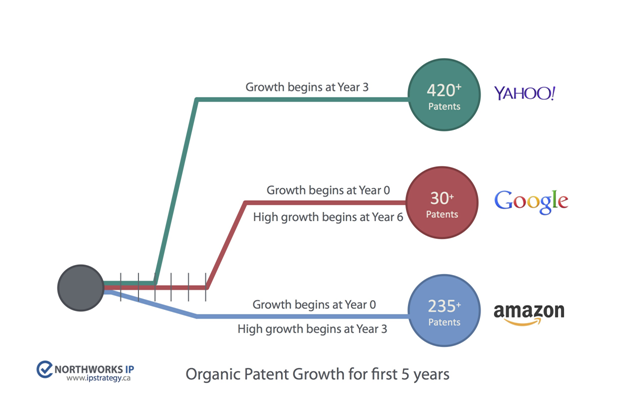
Source: IPStrategy
If you’re conversant with the digital marketing space, you’ve probably read ugly stories of brands that are not getting results with voice search. They claim that their interactions with voice searchers aren’t yielding results.
That’s good news for you. If you can generate a lot of excitement, your brand will stand out in the crowd.
We’ve seen how new mediums like augmented reality became a phenomenon, it’s only a matter of time before a brand does. Could it be you?
Voice Search and Local SEO: The Marriage?
With improvements in smart technology, businesses that rely on local search traffic to thrive can leverage this rare opportunity to reach their customers and answer their questions.
Having a realistic local SEO strategy has become critical to companies that are reaching out to local consumers.
As a company, you MUST not be left behind when it comes to local search, especially in this voice-driven search environment.
What’s Going On With Voice Search, Google?
The growth of the voice search is alarming. These days, local consumers are asking questions via voice to find local companies. For example, last week when I ordered Pizza, I didn’t type a word. I simply asked Google, “where can I order Pizza in Houston?”
And boom, Domino’s was right there.
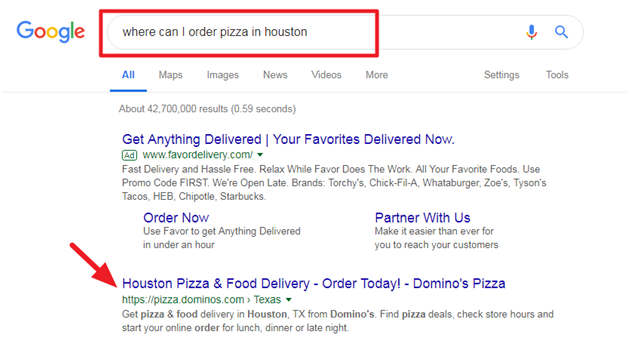
About 3 years ago, MindMeld, a conversational AI firm surveyed smartphone users in the United States and found that 60% of users who used voice search had started using it in the previous year. This shows a rise in adoption rates.
This result is backed up by Mary Meeker’s 2016 Internet Trends Report, which found that in 2016, Google voice search queries are up 35X over 2008. This makes up the entire 20% of searches conducted via the Google Android app.
This trend is obvious. And people prefer using them. Why?
Because voice searches are fast and convenient. Humans usually speak 150 words per minute, compared to typing at 40 wpm. More so, voice search is hands-free, instant, and increasingly reliable.
A big factor in voice search is the voice accuracy of voice searches. That’s why adoption in the US increased from 30-65% between 2013-2015. There’s a great improvement in technology, as cited by many, which is a great motivating factor for its usage.
When voice search was first introduced, the voice recognition wasn’t that great. The accuracy was less than 80%, thus, making the service complex and uninteresting to us. Today, Google’s word accuracy rate has exceeded 90%.
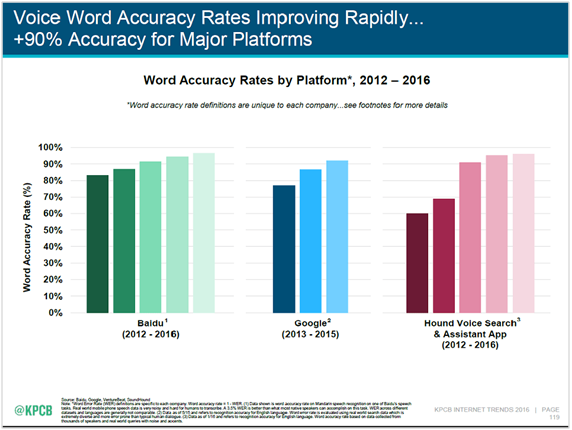
But the real factor contributing to this global adoption has been the simplified virtual assistants like Siri, Google Assistant, Cortana.
These smart assistants will automatically conduct a relevant web search if they can’t answer a question natively. Isn’t that awesome?
How Users Use Voice Search
We all use voice search differs from a typical search box. In a voice search, we tend to use conversational queries that are long, clear, and to the point. Most voice searchers prefer to use natural language to find information instead of keywords.
And there’s a difference.
A user might type in:

Interestingly, the same user would tell a voice assistant:

The second query is conversational and tells exactly why the user needs a plumber. This question requires a lot of analytical processes to provide the right solution.
As technology evolves, online marketers and business entrepreneurs should focus on building voice-based strategies into their marketing strategy.
So many brands are already doing it. Domino’s, Microsoft, and Amazon, in particular, that has already made it easy to order products with voice.
Capital One bank has also simplified online banking and paying off credit cards with voice commands. HSBC bank isn’t left out either. With its Voice ID, users can easily access banking apps tailor-made for them. Say bye-bye to passwords. Lol!

I thought I should still mention how smart Domino’s voice-order Technology is, it’s a breath of fresh air. What a time to be alive!
Although these voice-empowered technologies aren’t easy to come by, as they require heavy investments in time, resources, and money, local businesses that don’t have that the capacity shouldn’t give up.
If you’re a local business, here’s how to tap into voice search and marry it to your local SEO strategy:
Find the Local Opportunity to Tap Into
The best way to leverage voice search in your local SEO strategy is by finding loopholes that your competition hasn’t bumped on yet.
Voice search thrives on high-quality and conversational content. I’m talking about the type of content that answers specific questions.
It’s time for your brand to start producing a robust voice content experience, give valuable tips, and optimize your pages with long-tail, informational keywords that drive engagements.
When it comes to local searches, in particular, it makes sense to optimize your pages for keywords like “near me” and “nearby”.
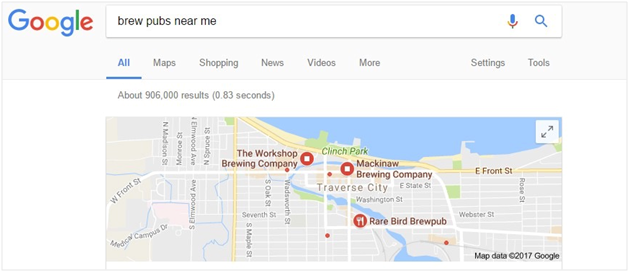
Ensure that your NAP (Business Name, Address, Phone Number) is consistent and accurate across the web. This is important so you don’t confuse Google crawlers.
When you claim your business in Google My Business platform, you should also list your daily opening hours. You’ll attract a lot of enquiries from customers who are looking for businesses that are “open now”.

When it comes to local SEO strategy, content marketing is always an important aspect of it. So find content marketing opportunities that leverage influencers and bloggers in your industry.
The more they talk about your brand and cite (even without a link) it, the more relevant your brand’s website will appear in Google’s eye. And all these are important for improve local search rankings.
Create useful and helpful experiences for your local business that others can gladly talk about.
Since they’ll spread the news using informal and conversational language, which are at the core of voice search, you’d increase your chances of showing up as a voice search result.
Integrate Voice Search Into Your Local Strategy
I have mentioned the importance of voice search in your local SEO strategy. I think it’s worth elaborating here. So let’s deal with it.
A part of your local strategy is ‘being everywhere.’ This simply means getting the word out about your business, products and services.
You want to sponsor local events, participate in a cause, host a contest, speak at local events, etc.
If you want people to come to your website/business, then you need to be prepared before they even conceive it.

You never know how far the experiences you create can go. So don’t leave any stone unturned. Spread your local identity far and wide.
Ideally, create a high-converting landing page to cater for every location. Make sure the landing page is optimized primarily for people in that geographical location. This is important.
When you do this, you’ll be able to run ads targeting people who are close enough to visit your Restaurant, for example, or call your phone number.
Don’t worry about user’s attitude which can be disappointing at times. It doesn’t matter whether they turn off tracking software, you’re still in good hands.
Because Google follows them to determine where they are, and you’ll serve “near me” search results to the last known location.
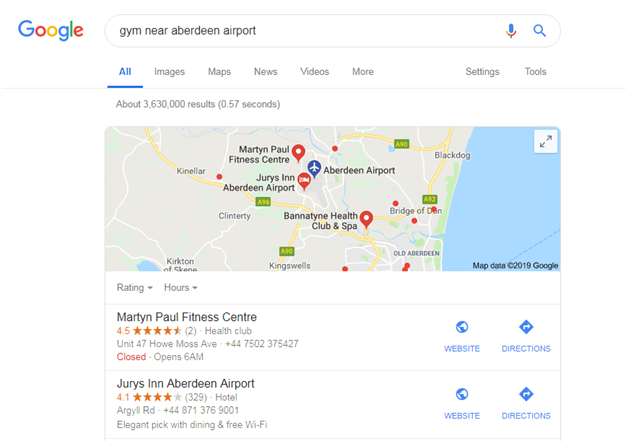
Final thoughts
Voice search is here and it’s transforming how online users find information online.
To help you maximize your brand reach, especially when you’re tailoring your message to local consumers, make sure you include reviews to boost your search rankings.
There are several plugins you can use to feature reviews on your web pages. This practice might look simple and common, but that’s exactly what moves the needle when it comes to ranking higher in Google local map pack.
Above all, make sure you ‘naturally’ integrate conversational queries into your content. Before the Panda and Penguin Algorithm updates, it was all about optimizing your pages for keywords.
Today, valuable content should appeal to mobile users and voice searchers alike. In fact, brands need to create content that aligns with customers and how they speak, and this will differ in your different industries and countries.


